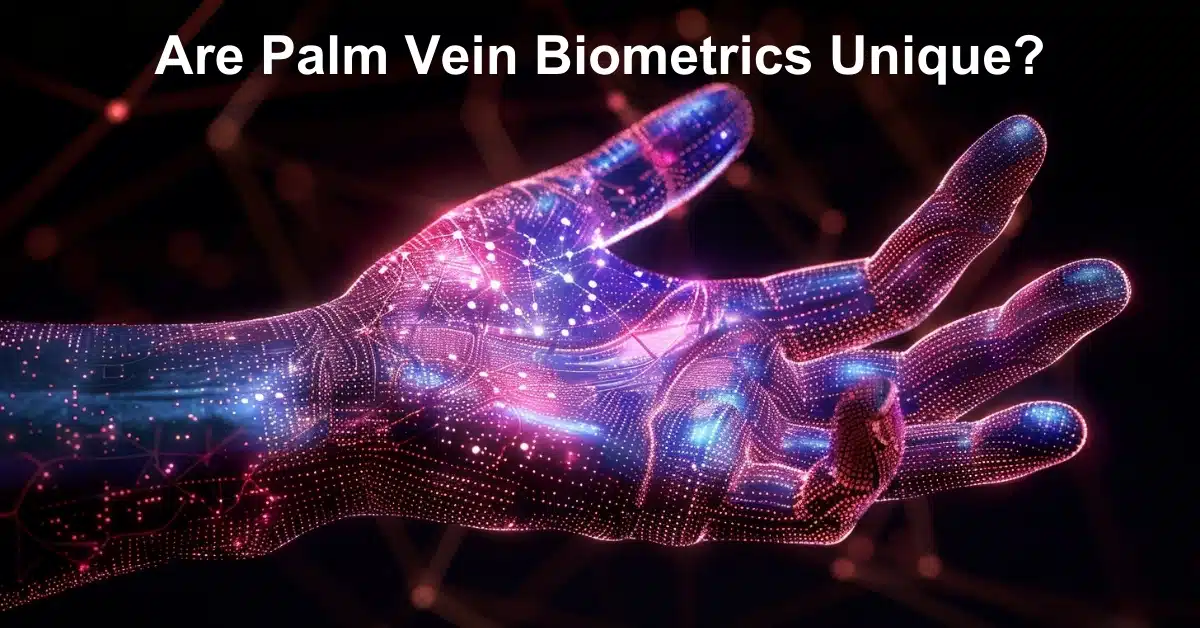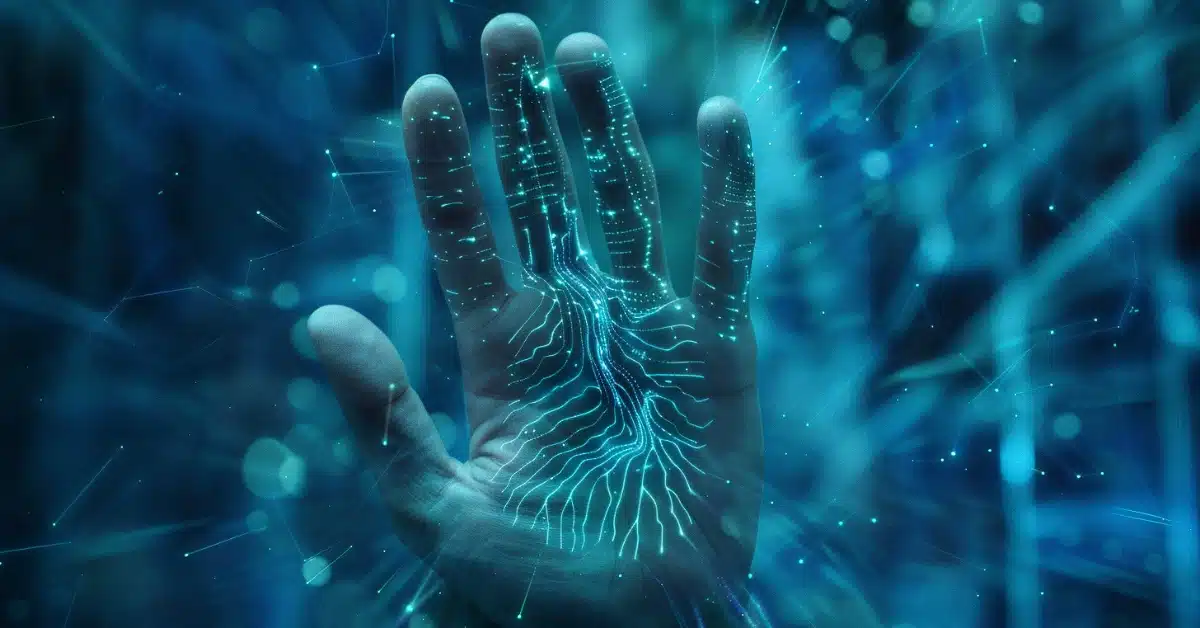In a world increasingly concerned with security and privacy, palm vein biometrics have emerged as a forefront technology, promising a unique blend of security, convenience, and privacy. But how unique and reliable is this technology? Let’s delve into the intricate world of secure identification and find out if palm vein biometrics are unique.

Palm vein biometrics, a relatively new player in the biometric security arena, uses the unique patterns of veins in the palm to identify individuals. This method stands out for its non-invasive, hygienic approach to personal identification, leveraging the fact that the pattern of blood vessels in each person’s palm is unique and stable over time.
The technology behind palm vein biometrics is sophisticated yet straightforward. When near-infrared light is transmitted through the palm, it is absorbed by the haemoglobin in the blood, making the veins appear as a black pattern against the lighter background of the palm. This pattern is then converted into a biometric template and stored for future comparison. The process is fast, secure, and, most importantly, non-contact, making it particularly appealing in the post-pandemic world.
The rise in popularity of palm vein biometrics can be attributed to several factors, including their high level of accuracy, difficulty to forge, and the non-contact nature of the scanning process. Additionally, palm vein patterns are not visible to the naked eye, adding an extra layer of security against potential breaches.
Yes, at the heart of palm vein biometrics’ appeal is the uniqueness and complexity of palm vein patterns. These intricate patterns offer a highly secure method of identification, distinctively different from other biometric systems.
Every individual possesses a unique set of palm vein patterns that are formed in utero and remain unchanged throughout one’s life. The complexity and uniqueness of these patterns are due to the intricate network of blood vessels in the hand, which differ from person to person in layout, size, and shape. This uniqueness makes palm vein biometrics one of the most secure and accurate forms of identification.
The physiological characteristics of palm vein patterns are inherently linked to genetics and are unaffected by external factors, making them highly stable and reliable for biometric identification. Unlike surface-level characteristics, such as fingerprints, which may wear down or be altered due to external conditions, the veins’ subcutaneous positioning protects them from damage, ensuring their integrity over time.
When compared to other biometric systems like fingerprints, facial recognition, or iris scanning, palm vein biometrics stand out due to their robustness against forgery and spoofing. The technology’s reliance on an internal body feature significantly reduces the risk of duplication or manipulation, offering a higher security level. The uniqueness of palm vein patterns, coupled with advanced scanning technology, positions palm vein biometrics as a formidable player in the security sector. This technology not only enhances the security of systems but also introduces a level of convenience and user-friendliness not seen in other biometric modalities.

Palm vein biometrics stand out in the biometric technology landscape for their unique advantages, making them increasingly popular across various applications. Their benefits extend beyond just security, offering enhanced convenience and privacy.
The inherent uniqueness and internal location of palm vein patterns grant a level of security that is nearly unparalleled. Unlike fingerprints, which can be left on surfaces and potentially replicated, or facial recognition, which can sometimes be fooled by photographs or masks, the palm vein patterns reside beneath the skin’s surface. This characteristic makes them almost impossible to forge or replicate, providing a robust security measure that is highly resistant to spoofing or identity theft.
Palm vein biometrics offer a seamless and efficient user experience. The scanning process is contactless, a significant advantage in today’s health-conscious world, reducing the transmission risk of pathogens. Additionally, with devices like the SmartHubPro, the identification process is rapid, often taking just a few seconds to complete, thereby offering a swift authentication method without the hassle of remembering and entering passwords or PINs. This convenience factor is a considerable draw for users who seek efficient and hassle-free security solutions.
The privacy and data protection offered by palm vein biometrics are superior due to the difficulty in replicating or stealing palm vein data. Since the biometric data is based on an individual’s unique vein pattern, which is invisible to the naked eye and hard to copy, it ensures a high level of personal data protection. This aspect is critically important in an era where data breaches and identity theft are rampant, providing users with peace of mind regarding the safety of their biometric data.
An additional advantage of palm vein biometrics is the stability of vein patterns over time. Unlike other biometric characteristics that might change due to aging, scars, or environmental factors, vein patterns remain constant throughout an individual’s life. This stability ensures that the biometric data does not need to be frequently updated to remain effective, further enhancing the convenience and reliability of palm vein biometrics for long-term use.
Palm vein biometrics represent a groundbreaking advancement in the realm of secure and private identification technologies. With their unique blend of high security, user convenience, and respect for privacy, they offer compelling advantages over traditional biometric systems. The technology’s ability to accurately identify individuals based on the unique patterns of their palm veins – unaffected by external factors and nearly impossible to forge – sets a new standard in security.
From enhancing ATM transactions in the banking sector to ensuring accurate patient identification in healthcare and beyond, palm vein biometrics are carving out a niche as a versatile, reliable solution across various industries. As we look to the future, the potential applications of this technology are vast and promising, heralding a new era of secure, efficient, and privacy-conscious identification.
The journey of palm vein biometrics, from emerging technology to integral part of our security infrastructure, underscores the continuous innovation and adaptation in the quest to keep our personal and professional environments safe and secure.
While no biometric system can be considered entirely foolproof, palm vein biometrics offer a very high level of security due to the uniqueness and internal nature of vein patterns. The chances of two individuals having the same palm vein pattern are extremely low, making it one of the most secure biometric identification methods available.
Palm vein patterns are highly stable and do not change significantly over time. Minor changes due to aging or health conditions do not affect the overall pattern, ensuring reliable identification throughout a person's life.
Palm vein scanners use near-infrared light, which penetrates the skin and is absorbed by the blood in the veins. This process makes the technology largely unaffected by external lighting conditions, ensuring consistent performance in various environments.
In the unlikely event of a system failure, such as a scanner malfunction or an unreadable vein pattern, most systems are equipped with fallback procedures. These might include alternative biometric methods, manual identity verification processes, or temporary access codes to ensure that operations can continue smoothly.
No, palm vein biometrics are considered non-invasive. The scanning process is contactless and does not require any form of physical contact with the scanner, making it hygienic and user-friendly.
The identification process with palm vein biometrics is very quick, typically taking just a few seconds from the moment the hand is presented to the scanner until identification is confirmed.
Palm vein scanners require direct exposure to the palm for accurate scanning. Therefore, thick gloves or materials that block near-infrared light can interfere with the scanning process. However, advancements in technology may address this limitation in the future.
Generally, palm vein biometrics are not affected by surface skin conditions since the scanner reads the vein patterns beneath the skin's surface. However, severe conditions that significantly alter blood flow or the structure of the veins could potentially impact scanning accuracy.
The data collected by palm vein biometric systems is typically encrypted and stored securely. Organisations implementing this technology prioritise data security and comply with relevant data protection regulations to protect individuals' privacy.
Yes, palm vein biometrics are scalable and can be used for large-scale identification purposes, such as national ID programs, airport security, and more. The technology's accuracy and speed make it suitable for handling large volumes of identifications efficiently.